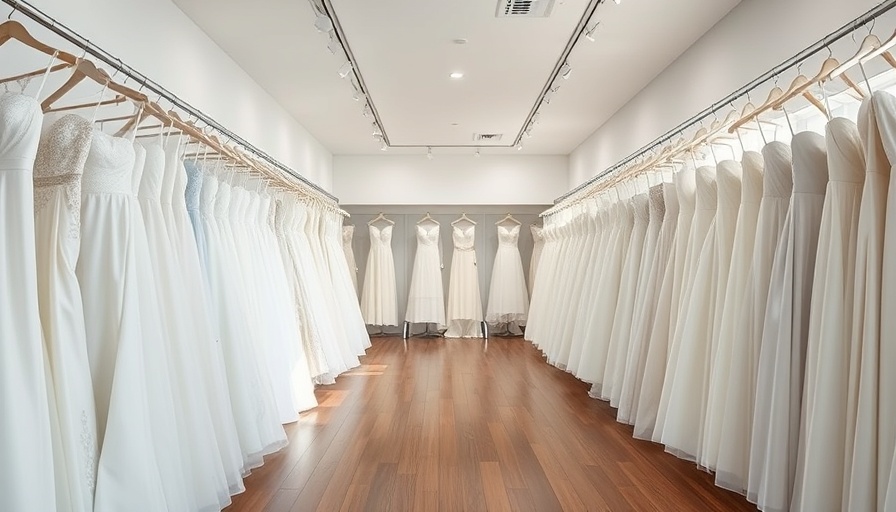
The Impact of Tariffs on the Wedding Dress Industry
In a world where wedding planning is often seen as a joyful journey, the reality for many bridal boutiques and wedding dress designers has changed dramatically due to recent tariff hikes imposed on Chinese imports. These tariffs, a major focus of President Trump's administration, have escalated costs for everything from wedding gowns to fabric and accessories, throwing a wrench into an industry that thrives on delicate pricing structures and relationships with manufacturers overseas.
Why China Matters to Bridal Fashion
According to industry reports, China has been a pivotal hub for bridal apparel, accounting for the majority of wedding dress manufacturing as well as the sourcing of essential materials. Brands like Mon Cheri and Justin Alexander have begun implementing tariff surcharges, placing additional financial burdens on consumers and local shops. These price increases could lead to a downturn in sales, particularly for small business owners like Denise Buzy-Pucheu, who owns The Persnickety Bride in Connecticut.
In a candid video message shared on social media, Buzy-Pucheu emphasized the challenges brought on by the 145% tariff, stating, "Almost all bridal gowns are made in China, along with many of the fabrics and materials we use. This type of work is not just something you can pick up and bring to the U.S.; we simply don’t have the skilled technicians here." This striking reality illustrates how industries rely on a global supply chain, where production expertise and affordable labor have historically made high-quality gowns accessible to many American families.
The Perspective of Local Retailers
Small bridal shops often rely heavily on sales from local customers, but the current economic climate is creating challenges that could jeopardize their future. The National Bridal Retailers Association is actively campaigning against these tariffs, pushing for lawmakers to consider exemptions. With a rich tapestry of local businesses woven into the fabric of their communities, the struggle of these boutiques is not just about finances; it's about preserving local culture and the personalized experience that comes with wedding planning.
Future Predictions: The Landscape of Bridal Retail
The future of bridal retail may hinge on how the U.S. responds to these economic stresses. Retailers are already exploring production opportunities outside of China—some shifting manufacturing to different regions where labor may not be as affordable but offers quality craftsmanship without staggering tariffs. Brands such as David's Bridal are rushing to adapt, but the transition isn't swift, and the impacts are immediate. Customers may find their shopping experience altered as fewer options become available and costs rise further.
Counterarguments: What's at Stake?
While some may argue that tariffs protect American jobs, the immediate fallout suggests that small businesses in the bridal industry are suffering as a result. In an effort to increase domestic production, the imposition of tariffs has pushed many small shops to the brink. As prices rise, supply chains are disrupted, and consumer choices decrease—creating a ripple effect that could lead to lasting changes in the industry.
Emotional Connection: Understanding the Bride's Perspective
Brides and grooms preparing for their special day may not understand the complex ramifications of trade policies. For many, shopping for a wedding gown represents a life milestone, something that should be celebrated with joy, not overshadowed by rising costs or fewer options. As local bridal boutiques face unprecedented challenges, the personal experiences of brides who cherish relationships with their boutique owners are at risk just as much as the shops themselves.
The Urgent Need for Dialogue
The current circumstances highlight the critical need for open dialogue between government, manufacturers, and local retailers. Bridal shops are more than just points of sale; they are part of the fabric of our communities, contributing immeasurable societal value beyond simply selling dresses. Keeping these businesses afloat may require either a reevaluation of tariffs or exploring other avenues to support local retailers.
As constituents, members of the bridal industry are urged to advocate for their interests, recognizing that the repercussions of policy decisions impact more than just business; they touch lives, dreams, and futures. As pressures mount, it becomes increasingly necessary for everyone involved in the wedding dress industry—designers, small shop owners, and even brides—to unite, bringing a shared voice to a complex issue.
 Add Row
Add Row  Add
Add 




Write A Comment